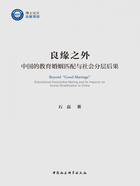
Abstract
In recent years,the impact of marriage on social stratification has received significant attention from social stratification researchers. This study employs two explanatory mechanisms,namely social exclusion and social structurization,to explore the influences of educational assortative mating on incomegap and the openness of social stratification structure in Chinese society.
Regarding income gap,we argue that the impact of educational assortative mating on income gap relies on two major factors. First,it depends on the distribution structure of educational homogamy across the entire educational hierarchy. Second,it depends on the degree of isomorphism between educational assortative mating and income assortative mating.
In analyzing the distribution structure of educational homogamy,this study further distinguishes social exclusion in educational assortative mating into action-level exclusion based on the preference of educational resources (educational resources exclusion,thereafter) and structural-level exclusion based on the educational marriage market (educational marriage market exclusion,thereafter). This study investigates how these two types of social exclusion influence the distribution of educational homogamy across the entire educational hierarchy. The research findings are as following:Firstly,in terms of educational resources exclusion,under the background of market transition and the expansion of higher education,there is a significant increase in the degree of exclusion between tertiary level and other levels of education. Meanwhile,the exclusion between primary level and other levels of education has also strengthened. Secondly,regarding educational marriage market exclusion,there is a continuous strengthening of marriage market exclusion within higher educated strata,leading to a significant increase in educational homogamy. Therefore,under the influence of educational resources exclusion and educational marriage market exclusion,educational homogamy in China gradually concentrates at both higher and lower educational levels,exhibiting a polarized trend. When analyzing the isomorphism between educational assortative mating and income assortative mating,this study finds that with the gradual deepening of market transition,the isomorphism between educational assortative mating and income assortative mating in China has been continuously strengthened.
The polarized distribution structure of educational homogamy and the high degree of isomorphism between educational assortative mating and income assortative mating have led to the emergence of “the rich marrying the rich” in advantaged social classes and “the cumulative disadvantage” in disadvantaged social classes in terms of income as well as other education-related resources and opportunities at the family level. This study reveals that since the 1990s,the income gap calculated based on different types of educational assortative mating families has been widening,indicating that the changes in educational assortative mating have significantly increased the level of income inequality in Chinese society.
In terms of the openness of social stratification structure,this article breaks down the structurization mechanism into coordinated structurization and intragenerational and intergenerational autogenic structurization.
When analyzing cooperative structurization,this study examines the joint structuring effects between educational assortative mating and intergenerational reproduction. The research findings indicate that individuals from better family backgrounds are more likely to form educational homogamy and hypergamy,while less likely to enter hypogamy. This implies that educational assortative mating not only further reinforces the solidifying effect of intergenerational reproduction on social stratification structure when it operates normally,but also serves as a compensatory mechanism and a potential pathway for upward mobility when intergenerational reproduction experiences “dysfunction”,and thus maintaining the inequality of resource and opportunity distribution. Moreover,the negative impact of their interaction on the openness of social structure intensifies in recent birth cohorts.
When analyzing intragenerational autogenic structurization,this study examines the influence of spouse's educational attainment on individual's social mobility after marriage. The research findings are as following:Firstly,in Chinese society,the higher the educational level of an individual's spouse,the more likely he or she will experience upward social mobility after marriage,indicating the existence of a “bidirectional spousal positive effect.” This effect is particularly prominent among individuals born after 1980. Secondly,there is no significant difference in the degree of spousal positive effect between educational homogamy and educational heterogamy,suggesting the absence of a “catch-up effect”. These results imply that educationally homogamous couples at higher-education level can maintain an advantage in intragenerational upward mobility through the support provided by their spouses,while the opposite is true for educationally homogamous couples at lower-education level. As a result,the social polarization caused by educational assortative mating intensifies over time,leading to the Matthew effect of “the rich get richer and the poor get poorer”,and thus deepening the degree of stratification structure solidification.
When analyzing intergenerational autogenic structurization,this study discusses the relationship between educational assortative mating in parental generation and their educational achievement in child's generation. The findings indicate that both the father's and mother's educational level have significant and relatively independent positive effects on the educational attainment of their offspring. Moreover,the strength of paternal educational reproduction is significantly stronger in educationally homogamous families. This means that the social status advantages possessed by educationally homogamous couples at higher-education level will be maintained or even strengthened in the next generation,while the disadvantages of educationally homogamous couples at lower-education level will continue in the next generation. Consequently,social inequality resulting from educational assortative mating is reproduced intergenerationally.
In summary,educational assortative mating not only widens social income gap through the mechanism of social exclusion but also contributes to the solidification of social stratification structure through the mechanism of social structurization.
Key Words:educational assortative mating,social stratification,income gap,social exclusion,social structuralization